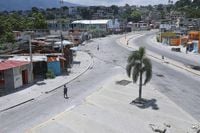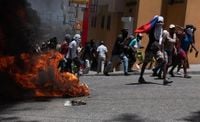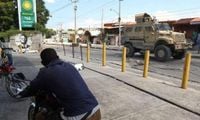On September 4, 2025, the United States and Panama took a decisive step at the United Nations, urging the Security Council to authorize a new, robust multinational force in Haiti—one that would be unlike any previous mission. Their proposal: a 5,550-strong force, empowered not just to support local authorities, but to detain, arrest, and dismantle the gangs that have thrown the Caribbean nation into chaos since the assassination of President Jovenel Moïse in 2021. The details, revealed in a six-page draft resolution obtained by multiple news outlets including the Associated Press, reflect a dramatic escalation in international response to Haiti’s deepening crisis.
For the people of Port-au-Prince and beyond, the urgency is palpable. According to Latin American Post, gangs now control an estimated 90% of the capital city. Their grip has expanded far beyond the urban core, with looting, kidnapping, sexual assaults, and rape becoming tragically commonplace, even in rural regions. The government, headless since Moïse’s assassination, has been unable to restore order. Elections remain a distant hope, and the Haitian state’s authority has been all but eclipsed by criminal networks.
The proposed force represents a significant shift in both scale and scope from the current Kenya-led Multinational Security Support mission, which first deployed troops to Haiti in June 2024. That mission, initially envisioned as a 2,500-strong deployment to stabilize the country, has struggled to make an impact. Fewer than 1,000 troops are currently on the ground, hampered by chronic funding shortages and a lack of clear authority to engage gangs directly. As Latin American Post noted, "the hope once placed in the Kenyan-led Multinational Security Support mission has been eroded by grim math."
U.N. Secretary-General António Guterres, in a February 2025 assessment, acknowledged that the current mission is "outgunned and unable to counter gang expansion effectively." The new draft resolution, put forward by the U.S. and Panama, echoes this finding and calls for urgent reinforcement. It would authorize U.N. member nations, in cooperation with Haiti’s government, to transition the existing mission into a new Gang Suppression Force for an initial 12-month period, with the possibility of renewal.
The proposed force would consist of 5,500 uniformed personnel and an additional 50 civilian staff, all funded through voluntary contributions. However, the draft does not specify which countries will provide troops or police officers—a notable omission that leaves the mission’s future composition uncertain. Kenya remains the symbolic leader, but whether it can supply thousands more personnel is unclear. The plan’s reliance on voluntary funding also raises concerns about the risk of underfunding, which has already hampered previous efforts.
What sets this proposal apart is its muscular mandate. As outlined in the draft, the force would have the authority to "detain and arrest Haitians," a power rarely granted to international peacekeeping missions. This is not just about standing behind the Haitian police. The force would be empowered to conduct independent, intelligence-led targeted counter-gang operations to neutralize, isolate, and deter gangs that threaten the civilian population, abuse human rights, and undermine Haitian institutions. According to the Associated Press, the goal is to "transform the Kenya-led multinational force now deployed in the Caribbean nation into a much larger force in a draft resolution to the U.N. Security Council."
The force’s responsibilities would extend beyond direct confrontation with gangs. It would provide security for critical infrastructure—airports, ports, schools, and hospitals—alongside Haitian police and armed forces. The draft resolution also calls for support in combating illicit trafficking and the diversion of arms and related materiel, addressing the international dimensions of Haiti’s domestic crisis. As Latin American Post observed, "the vision isn’t just to confront gangs in firefights. The goal is to isolate them, cut off their supply chains, and dismantle the structures—both physical and economic—that allow them to thrive."
For many in Haiti and the international community, the stakes could not be higher. Schools have shut down, aid convoys can’t pass, and hospitals are either fortified or closed, according to reports from Latin American Post. Humanitarian workers describe Port-au-Prince as a patchwork of "no-go zones." Access to clean water, electricity, and health services is deteriorating by the week. Warlords rule entire neighborhoods, and the suffering of ordinary Haitians deepens each day the crisis continues.
Yet, despite the clear need for action, the proposal is not without its critics and skeptics. Memories of past international interventions in Haiti—some of which were marred by scandal or heavy-handed tactics—still loom large. Regional governments and local civil society groups have voiced concerns about sovereignty, the risk of abuse, and the importance of coordination with Haitian institutions. In private meetings, U.N. officials have emphasized that the goal is not occupation, but stabilization, with a strong focus on respecting human rights and working in partnership with local authorities.
Acting U.S. Ambassador Dorothy Shea underscored the urgency and necessity of the new approach. On August 28, 2025, she announced that the U.S. was seeking U.N. authorization for a Gang Suppression Force, making it clear that "a Gang Suppression Force is no longer a wish—it’s a necessity." This sentiment is echoed in the draft resolution, which appreciates Kenya’s leadership but stresses the need for a more forceful and better-resourced response.
Time is running out. The current Kenya-led mission’s U.N. mandate expires on October 2, 2025, and a Security Council vote on the new resolution is expected by the end of September. In diplomatic terms, that’s a blink of an eye. Every day that passes, the gangs tighten their grip, and the situation becomes harder to reverse. As Latin American Post puts it, "what Haitians need is safety. What the U.N. needs is a mandate strong enough to deliver it. And what the world must now decide is whether it has the will to finally match its words with the muscle Haiti’s crisis demands."
Whether this bold new force will succeed where previous efforts have faltered remains to be seen. The coming weeks will determine not just the fate of the proposal, but perhaps the future of Haiti itself.



